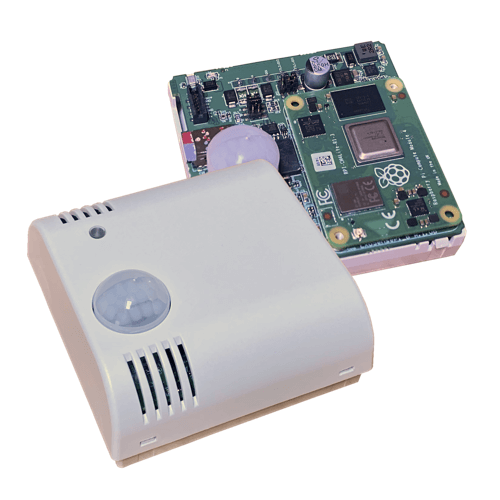ExoSensePi
Exo Sense Pi is a multi-sensor module with a Raspberry Pi 4 computing core and a wide range of connectivity options.

This driver provides support for both a local installation of HSYCO on Exo Sense Pi itself, or a remote Exo Sense Pi unit connected via SSH. In both cases, the Raspberry Pi OS Kernel module for Exo Sense Pi must be installed. The kernel module documentation is available at GitHub and the Exo Sense Pi User Guide.
HSYCO Configuration
Add a Exo Sense Pi I/O Server in the I/O Servers section of the Settings and set its parameters:
Note that the Exo Sense Pi I/O Server doesn't count in the I/O servers license total, so you don't need an extra I/O Server license to use Exo Sense Pi with HSYCO.
Communication
- IP Address: the IP address assigned to Exo Sense Pi, leave blank for a local installation
- Port: SSH port configured on Exo Sense Pi (defaults to 22), leave blank for a local installation.
Authentication
- User: username to access the remote Exo Sense Pi via SSH, leave blank for a local installation
- Password: password to access the remote Exo Sense Pi via SSH, leave blank for a local installation.
High Availability
- Shutdown when inactive: defaults to false.
Options
| ID | Default | Values | Description |
|---|---|---|---|
| startupevents | false | true | generate IO events also during the driver’s start-up phase |
| false | start generating events only after HSYCO is aligned with the current status of the system | ||
| pollinterval | 250 | 10 <= n <= 30000 | the data acquisition interval, in milliseconds |
| skip | <list> | Space or semicolon separated list of datapoints or prefixes (not including the I/O Server id). Datapoints starting with one of the keywords defined in the skip list are not polled. Skipping unused datapoints improves polling performance on both local and remote configurations |
Datapoints
The Exo Sense Pi implements all data points provided by the underlying Exo Sense Pi kernel module. Refer to the documentation available at Exo Sense Pi Kernel Module.
Each readable file name exposed by the kernel module under the /sys/devices/virtual/exosensepi/ sub-directories appears as a data point with id <subdir>.<file>. For example, as the buzzer's status file is /sys/devices/virtual/exosensepi/buzzer/status, the corresponding data point is "buzzer.status".
Command files that are marked as write only in the documentation (W), are not shown as visible data points in HSYCO, but can be used in the IO events action or ioSet() methods to send a command.
For example, if "exo" is the id assigned to the Exo Sense Pi I/O Server, then:
TIME : IO exo.buzzer.beep = 1000
will make the buzzer beep for 1 second (1000 ms).
Note that "exo.buzzer.beep" is not visible in the Status Browser and doesn't generate events, because it is write only, and only the "exo.buzzer.status" data point will be visible, with a value of 0 if the buzzer is not active, or 1 if active.
Additional datapoints
| ID | Value | R/W | Description |
|---|---|---|---|
| connection | online | R | connection established |
| offline | R | HSYCO can't connect to the device |
Release Notes
3.8.0
- initial release
Exo Sense Pi is a registered trademark of Sfera Labs Srl